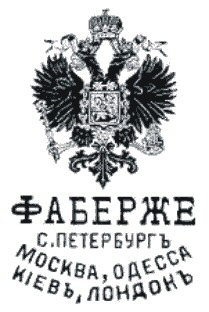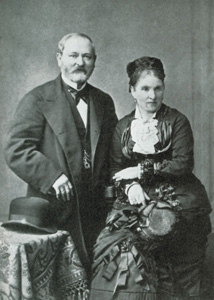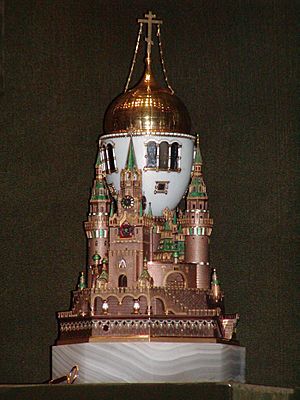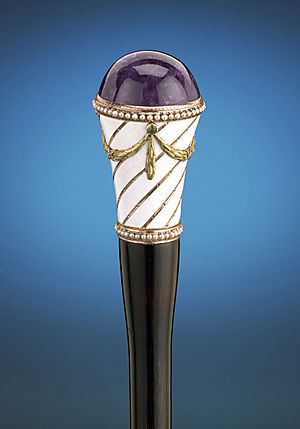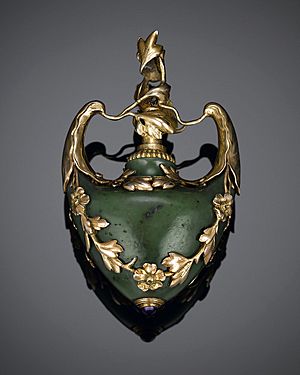House of Fabergé facts for kids
The House of Fabergé is a famous jewellery company. It started in 1842 in Saint Petersburg, Russia. Gustav Fabergé founded the company. His sons, Peter Carl and Agathon, and later his grandsons, continued the business. The company was known for creating amazing, jewel-covered Fabergé eggs for the Russian emperors. They also made many other beautiful and detailed items.
After political changes in Russia around 1917, the family had to leave. Later, in 1924, Peter Carl's sons, Alexander and Eugène Fabergé, opened a new company in Paris, France. They made similar jewelry and called their firm FABERGÉ, PARIS. Over the years, the Fabergé name was used for many different products. These included perfumes, colognes like Brut, clothing, and even movies. The brand changed owners several times. Eventually, it returned to making only jewelry. Today, the Fabergé brand is owned by Fabergé Limited. It focuses on beautiful jewelry and gemstones.
Contents
The Beginning of Fabergé
The Fabergé family came from France in the 1600s. They had to leave their home country around 1685 because of their religious beliefs. Many other French Protestants, called Huguenots, also became refugees.
As the family moved across Europe, their name slowly changed. It went from Favri to Faberge. By 1814, a boy named Gustav Fabrier was born in what is now Estonia.
In the 1830s, this Gustav Faberge moved to Saint Petersburg, Russia. He trained to become a goldsmith. He learned from famous craftsmen who made beautiful items for emperors. In 1841, Gustav Fabergé became a Master Goldsmith. This meant he was an expert in working with gold.
Gustav married Charlotte Jungstedt. In 1846, they had a son, Peter Carl Fabergé. He became known as Carl Fabergé.
Carl Fabergé Takes Over
Carl Fabergé went to a good school. This showed how successful his father's jewelry business was. In 1860, Gustav Fabergé retired. He left the company to managers while Carl finished his studies. Carl studied business in Dresden, Germany. He also traveled around Europe to learn more. He learned from skilled goldsmiths in different countries. He visited museums to see beautiful art and jewelry.
Carl came back to Saint Petersburg in 1864. He joined his father's company. He was only 18, but he kept learning from the company's manager. In 1872, Carl took charge of the family business. The company moved to a bigger location in 1881. By 1882, Carl was the official head of the firm. That same year, he became a Master Goldsmith. His younger brother, Agathon Fabergé, also joined the company. Agathon was a very talented designer. He brought new ideas to the business.
Becoming Famous
Carl Fabergé helped repair old items in the Hermitage Museum. Because of this, his company was invited to a big exhibition in Moscow in 1882. Carl and Agathon Fabergé became very popular there. They showed a copy of an ancient gold bracelet. Tsar Alexander III was amazed. He said he couldn't tell the difference between Fabergé's copy and the real one. The Tsar ordered Fabergé's work to be shown in the Hermitage Museum. This was to highlight their amazing Russian craftsmanship. In 1885, the company received a special title. They became "Goldsmith by special appointment to the Imperial Crown". This started their close connection with the Russian emperors.
The Famous Imperial Easter Eggs
In 1885, Tsar Alexander III asked Fabergé to make a special Easter egg. It was a gift for his wife, Empress Maria Feodorovna. This first egg looked like a normal hen's egg from the outside. But it opened up to show a golden yolk inside. The yolk also opened to reveal a golden chicken. Inside the chicken was a tiny copy of the Imperial Crown. A small ruby egg hung from the crown. This first egg is now called the Hen Egg.
The Tsar loved the egg so much that he ordered one every Easter. Carl Fabergé was given complete freedom to design these eggs. Each egg became more detailed and surprising. The Fabergé family says that even the Tsar didn't know what the egg would look like. The only rule was that each egg must have a unique surprise inside. Fabergé made 50 Imperial eggs in total. The Tsars gave them as gifts to their wives and mothers. Today, 43 of these amazing eggs still exist.
Tiny Stone Sculptures
Fabergé also made popular miniature sculptures. These were tiny carvings of people, animals, and flowers. They were made from beautiful semi-precious stones. They were often decorated with precious metals and jewels.
The most common animal carvings were elephants and pigs. They also made custom miniatures of pets for the British Royal family. The flower sculptures were like small scenes. They had tiny vases with carved flowers set inside. The vase and "water" were made from clear rock crystal. The flowers were crafted from different stones and enamel.
These figures were usually small, about 25–75 millimeters long. Some larger ones reached 140–200 millimeters tall. People all over the world collected them. The British Royal family owns over 250 of these items. Even other jewelers, like Cartier, bought Fabergé miniatures.
Other Fabergé Creations
The House of Fabergé also sold many other beautiful items. These included jewelry, enameled gold and silver frames, and fancy boxes. They made desk sets, walking sticks, doorbells, and clocks. Carl Fabergé himself, or his eldest son Eugène, had to approve every item. This ensured the highest quality. Even the smallest flaw would cause an item to be rejected.
Growing the Business
The House of Fabergé won international awards. It became Russia's largest jewelry company. It employed about 500 skilled artisans and designers. In the early 1900s, Fabergé moved its main office to a new, four-story building. They also opened branches in Moscow, Odessa, Kiev, and London. From England, the company made yearly visits to the Far East.
European monarchs highly desired Fabergé's work. Queen Alexandra was a big fan. She was the wife of King Edward VII and sister to Empress Maria Feodorovna. Queen Alexandra often exchanged Fabergé art objects as gifts with her family. Other members of the British Royal family also collected Fabergé pieces.
After the Russian Revolution
In 1918, due to political changes, the Fabergé company was taken over by the new government in Russia. Carl Fabergé left Russia in October. He traveled to Germany, then to Switzerland. He passed away in Lausanne, Switzerland, on September 24, 1920.
His sons, Agathon and Alexander, faced difficulties. Agathon was asked to value the treasures taken from the imperial family. He later managed to escape Russia in 1927 with his family. They settled in Finland. Carl's wife and eldest son, Eugène, also managed to escape to Finland.
Fabergé & Cie in Paris
In 1924, Alexander and Eugène opened a new company called Fabergé & Cie in Paris. They had some success making jewelry similar to their father's designs. To show that their pieces were new, they used the stamp "FABERGÉ, PARIS." The original Russian company's stamp was just "FABERGÉ." They also repaired and restored items made by the original House of Fabergé.
Fabergé & Cie continued to operate in Paris until 2001.
Fabergé's Lasting Reputation
Fabergé's reputation for high-quality work has continued through the years. Major exhibitions, like those at the Victoria & Albert Museum, have showcased their pieces.
After the end of the Soviet Union, many wealthy Russian collectors wanted to bring Fabergé's works back to Russia. This caused auction prices to reach very high levels. For example, in 2007, the Rothschild Fabergé Egg sold for almost £9 million. This was a record price for a Fabergé item. It was also the highest price ever paid for a Russian object and a timepiece at that time.
Many famous people and wealthy individuals collect Fabergé pieces. The British Royal Collection has the largest Fabergé collection in the world. It includes hundreds of items, from Imperial Easter Eggs to animal sculptures and jewelry.
The Fabergé Brand Name
In the 1920s, an American businessman named Armand Hammer bought many original Fabergé items. Later, in 1937, Hammer's friend, Samuel Rubin, started a new company. He wanted to make perfumes and toiletries. Rubin registered his new company as Fabergé Inc. in 1937. In 1943, he registered the Fabergé name for perfume in the United States.
In 1945, the Fabergé family found out their name was being used without their permission. After discussions, an agreement was reached in 1951. Rubin agreed to pay the Fabergé family to use the name only for perfumes.
In 1964, Rubin sold Fabergé Inc. to a cosmetics company. This company changed its name to Rayette-Fabergé Inc., and then to Fabergé Inc. From 1964 to 1984, Fabergé Inc. launched many successful products. Brut cologne became the best-selling cologne in the world.
The company also expanded into other areas. They even started a film-making division called Brut Productions. This division produced the Academy Award-winning film A Touch of Class in 1973. In 1976, they launched the perfume Babe. It became Fabergé's best-selling women's fragrance worldwide.
Over the years, the Fabergé brand was bought and sold by different companies. It was used for clothing lines and other personal care products.
Fabergé Limited
On January 3, 2007, a company called Pallinghurst Resources bought all the global rights to the Fabergé brand name. They paid $38 million for it. These rights were acquired by a new company, Fabergé Limited.
In October 2007, Fabergé Limited announced its plan to bring the brand back to its original purpose. They wanted to make it a leading name in beautiful personal possessions. They also brought members of the Fabergé family back into the company. Tatiana Fabergé and Sarah Fabergé, great-granddaughters of Peter Carl Fabergé, joined a special council.
In September 2009, Fabergé Limited launched its first new jewelry collection. They opened a boutique in Geneva. By 2011, the company launched new collections of egg pendants. These were the first pieces made by a Fabergé company since the family left Russia in 1917. Fabergé opened boutiques in London and New York.
In January 2013, Fabergé Limited was sold to a gem mining company called Gemfields. In 2015, Fabergé won an award for its new timepiece collections. In 2017, the company started new advertising campaigns for both men's and women's ranges.
In 2020, Fabergé worked with The Craft Irish Whiskey Co. to create The Emerald Isle Collection. This collection included jewelry and other items, with a special Fabergé Egg. In 2025, the tech entrepreneur Sergei Mosunov purchased the rights to the Fabergé brand from Gemfields plc.
Important Fabergé Collections in Museums Around the World
Many museums around the world display amazing Fabergé creations:
- Fabergé Museum (Saint Petersburg, Russia): This museum has the world's largest collection of Fabergé works. It includes nine Imperial eggs.
- The Royal Collection (London, UK): This collection belongs to the British Royal Family. It has many Fabergé items, including animal sculptures, flower studies, and three Imperial eggs.
- Kremlin Armory Museum (Moscow, Russia): This museum houses ten Imperial eggs that were made for the Tsars.
- Virginia Museum of Fine Art (Richmond, USA): This museum in Richmond has five Imperial eggs.
- Hillwood Estate, Museum & Garden (Washington D.C., USA): This collection includes two Imperial eggs and other important objects, like a beautiful blue enamel clock.
- Hermitage Museum (Saint Petersburg, Russia): This museum features special Fabergé rooms. It displays pieces like tiny copies of the Imperial crown.
- The McFerrin Collection (Houston Museum of Natural Science, USA): A significant collection of Fabergé items.
- Fabergé Museum in Baden-Baden, Germany: Opened in 2009, this museum has over 700 items, including two Imperial eggs.
Gustav Fabergé Monument
A monument to Gustav Fabergé is located in Pärnu, Estonia. It was put up on January 3, 2015, to celebrate 200 years since his birth.
See also
 In Spanish: Casa Fabergé para niños
In Spanish: Casa Fabergé para niños
- Fabergé egg
- Fabergé workmaster
- Fauxbergé


